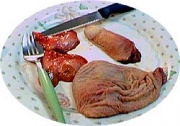Communion: Difference between revisions
Jump to navigation
Jump to search
(Created page with "<html><div class="mw-content-ltr" dir="ltr" id="mw-content-text" lang="en"><div class="thumb tright"><div class="thumbinner" style="width:182px;"><a class="image" href="/index.php?title=File:Communion-1.jpg"><img alt="Communion-1.jpg" class="thumbimage" height="126" src="/images/thumb/f/f3/Communion-1.jpg/180px-Communion-1.jpg" width="180"/></a> <div class="thumbcaption"><div class="magnify"><a class="internal" href="/index.php?title=File:Communion-1.jpg" title="Enlarge"...") |
(Page conversion via llm-mediawiki-rev -jwm) |
||
| Line 1: | Line 1: | ||
[[File:Communion-1.jpg|thumb|right|180px]] | |||
Outside of its more mundane definition, '''communion''' is also the moment at which a [[Cutter|cutter]] consumes the flesh of the person worked on (note that this interest represents only a small minority of cutters). The flesh may be consumed fresh and raw, or cooked. The word communion isn't chosen as a "joke" — cutters (and clients) who engage in this often consider it a genuinely spiritual event with genuine value to both of them. | |||
As of the beginning of 2004, there are a number of ongoing trials to determine whether this form of [[Cannibalism|cannibalism]] is legal or not. | |||
Latest revision as of 01:57, 17 September 2023
Outside of its more mundane definition, communion is also the moment at which a cutter consumes the flesh of the person worked on (note that this interest represents only a small minority of cutters). The flesh may be consumed fresh and raw, or cooked. The word communion isn't chosen as a "joke" — cutters (and clients) who engage in this often consider it a genuinely spiritual event with genuine value to both of them.
As of the beginning of 2004, there are a number of ongoing trials to determine whether this form of cannibalism is legal or not.
